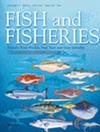Imputation of Fisheries Reference Points for Endangered Data‐Poor Fishes, With Application to Rhino Rays
IF 6.1
1区 农林科学
Q1 FISHERIES
引用次数: 0
Abstract
For data‐limited fish species, sustainable management frequently relies on biological metrics that are derived from life‐history trait data, as opposed to high‐resolution time series of catch and abundance. These biological metrics are used to assess a species' recovery potential at low population densities, as well as their extinction risk. However, for really data poor species, the life‐history traits required to derive these metrics are also often only partially known. Addressing this gap is essential for informing regulatory and conservation actions for vulnerable species and stocks lacking assessments. We developed a generalisable, phylogenetically informed framework for imputing missing life‐history traits across different taxa and applied it to 57 species within the order濒危数据贫乏鱼类渔业参考点的归算,并应用于犀牛鳐
对于数据有限的鱼类,可持续管理往往依赖于从生活史特征数据中得出的生物指标,而不是高分辨率的捕捞量和丰度时间序列。这些生物指标被用来评估一个物种在低种群密度下的恢复潜力,以及它们的灭绝风险。然而,对于真正缺乏数据的物种,获得这些指标所需的生活史特征通常也只是部分已知。解决这一差距对于为缺乏评估的脆弱物种和种群的监管和保护行动提供信息至关重要。我们开发了一个通用的、系统发育的框架,用于在不同分类群中推断缺失的生活史特征,并将其应用于犀牛鳐目(rhinopritiformes)中的57个物种,犀牛鳐目是一个进化上独特且高度濒危的群体,其生活史数据非常稀少。然后,我们使用输入的性状得出了四个关键的管理和保护指标:贝弗顿-霍尔特种群招募关系的陡峭度,最大可持续产量下的产卵潜力比,最大内在种群增长率和世代长度。我们发现平均生活史特征与三个管理指标之间存在很强的相关性。虽然由于种内变异、测量误差和有限的数据,管理指标的不确定性仍然很高,但与使用其他种群或同属物种的替代性状数据相比,使用重建性状减少了不确定性。我们提供了估算的性状值和相应的管理和保护度量标准,以及在任何后续的保护评估和管理策略评估中应该认识到的不确定性界限。该框架能够为数据有限的分类群生成一级、基于证据的管理和保护指标,从而支持在没有全面物种水平评估的情况下做出更明智的物种决策。
本文章由计算机程序翻译,如有差异,请以英文原文为准。
求助全文
约1分钟内获得全文
求助全文
来源期刊

Fish and Fisheries
农林科学-渔业
CiteScore
12.80
自引率
6.00%
发文量
83
期刊介绍:
Fish and Fisheries adopts a broad, interdisciplinary approach to the subject of fish biology and fisheries. It draws contributions in the form of major synoptic papers and syntheses or meta-analyses that lay out new approaches, re-examine existing findings, methods or theory, and discuss papers and commentaries from diverse areas. Focal areas include fish palaeontology, molecular biology and ecology, genetics, biochemistry, physiology, ecology, behaviour, evolutionary studies, conservation, assessment, population dynamics, mathematical modelling, ecosystem analysis and the social, economic and policy aspects of fisheries where they are grounded in a scientific approach. A paper in Fish and Fisheries must draw upon all key elements of the existing literature on a topic, normally have a broad geographic and/or taxonomic scope, and provide general points which make it compelling to a wide range of readers whatever their geographical location. So, in short, we aim to publish articles that make syntheses of old or synoptic, long-term or spatially widespread data, introduce or consolidate fresh concepts or theory, or, in the Ghoti section, briefly justify preliminary, new synoptic ideas. Please note that authors of submissions not meeting this mandate will be directed to the appropriate primary literature.
 求助内容:
求助内容: 应助结果提醒方式:
应助结果提醒方式:


